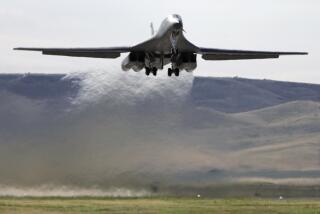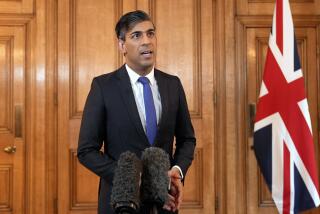Hunt On for Crew of British Plane Downed in Iraq
MANAMA, Bahrain — British pilots returned from their first attacks against Iraq with “jubilation and relief” Thursday, while a dramatic hunt was launched in the desert behind Iraqi lines for the two-man crew of a British bomber that went down early in the conflict.
A second Tornado was later reported lost. The fate of its crew was not known.
Group Capt. David Henderson, the Royal Air Force commander here, told a press briefing that Britain’s heavy Tornado GR1 fighter-bombers had targeted airfields in Iraq and Kuwait, but he declined to discuss their exact location. In addition, British forces sent aloft two massive fuel tankers that woke the island of Bahrain as they climbed into the darkness at about 1:30 a.m.
“We had a significant number of sorties, and they have all been successful,” Henderson said.
The attacks continued Thursday night.
The Tornados are equipped with heavy weapons called JP233 bombs, which contain 30 bomblets for cratering runways and another 215 explosives with delayed-action fuses designed to cripple ground personnel that attempt to clear away the rubble.
Asked about his pilots’ mental state after the night of air attacks, Henderson replied that “there was naturally some apprehension before the first raid amid jubilation and relief when they returned from the first raid.”
In London, British Defense Secretary Tom King confirmed the loss of one of the Tornado bombers used in the second wave of attacks, on Thursday. King said the plane suffered an engine fire, which suggested the possibility of a mechanical malfunction rather than an Iraqi counterattack causing the crash.
An RAF spokesman said the plane “went missing” over the desert and it was “presumed that the crew ejected safely.” The British Broadcasting Corp. said an emergency beacon indicated that the pilot and his navigator were safely on the ground.
The spokesman declined to reveal the area of the crash but said it was in the desert. British rescue units were reported to be conducting a frantic search for the fliers in an effort to pick them up before they could be located by the Iraqis.
U.S. and Kuwaiti forces also lost a single warplane each in the attacks, according to U.S. Air Force commanders and other sources. The U.S. Navy pilot was listed as killed in action; the fate of the Kuwaiti pilot was unknown.
“The missions have been accomplished with great skill and courage,” King said of the British attacks Thursday. Initial evidence indicated that “the targets were hit and the objectives were achieved,” he said.”
While saying that the available evidence pointed to having “very significantly damaged Iraq’s military capability,” King warned that Iraq may be conserving its air force and air defense missile resources rather than risking their loss at the outset of fighting.
“This is very early indeed in a very difficult challenge that we face against a country that possesses very considerable armaments, that possesses some very nasty armaments as well,” King said.
Henderson said none of the warplanes launched from Bahrain encountered any enemy air defense missiles. Air Force Chief Marshal David Craig, who joined King at the London briefing, said none of the British aircraft had encountered Iraqi warplanes either.
“They seem to have been caught by surprise, and no doubt the raids aimed at their command and control systems have made reaction very much more difficult for them,” Craig said.
“Command and control” refers to the complex web of communications channels that begin with radar intercepts of attacking aircraft to ground controllers coordinating antiaircraft defenses such as missiles and warplanes.
Craig said there were hundreds of allied combat aircraft and supporting tankers in the air at the same time and hundreds of nighttime refueling missions accomplished without a hitch.
“Our air commander in the theater op (operations) spoke of an air of quiet efficiency with timely information coming in from a whole variety of sensors,” Craig said.
More to Read
Sign up for Essential California
The most important California stories and recommendations in your inbox every morning.
You may occasionally receive promotional content from the Los Angeles Times.










